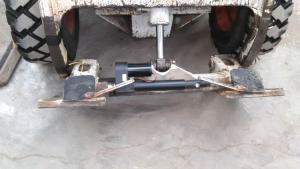Powered Quick-Attach Saves Time, Is Safer
 ✖  |
Dale McLaen uses an electric actuator to make his older skid steer’s quick-attach system even quicker. With the help of a couple of custom-made brackets, the actuator attaches to the 2 release arms. With its remote, the actuator easily releases one attachment and locks in the next.
“Getting in and out of my 743 Bobcat in the winter to manually lock and unlock the quick-attach levers was a real pain,” says McLaen.
He considered building a remote controlled release that is hydraulically operated like newer Bobcats have. “That requires knowledge and plumbing wizardry I don’t have,” he says. “Plus there is the risk of accidental hydraulic feedback. It could cause the quick-attach locking system to move by itself and allow the attachment to fall off.”
McLaen decided to go with an electric actuator. He ordered a 500-lb. capacity, 12-volt linear actuator from The Surplus Center (www.surpluscenter.com; ph 800 488-3407). The 8-in. stroke cylinder was equipped with a built-in clutch. It prevents jamming when the cylinder ends travel.
The actuator was about a foot short of the length needed to attach to the 2 levers. A local blacksmith machined a couple of 6-in. long brackets to fit on the ends of the actuator and attach to the locking levers. He added pivot pins to connect the brackets and the levers.
“I made a series of marks on the locking levers where I thought the pivot pins should go,” says McLaen. “Once I found the sweet spots, I drilled holes and welded in 7/16-in. pivot pins.”
McLaen also added a 30-amp, DC polarity, reversing toggle switch to control the actuator. “I mounted the toggle switch on the overhead dash in the cab along with a fuse holder,” he says.
When a winter snowstorm hit, the locking system was put to the test. McLaen switched back and forth between multiple attachments over a 5-hr. period.
“It worked as good and fast as a factory-installed, hydraulically-operated unit,” says McLaen. “It was great to be able to just push up and down on the toggle switch and watch the locking levers move up or down instead of getting in and out of the cab.”
Cost for the actuator and the toggle switch was $215. The fuse holder and wire ran another $20.
“If the actuator were to get damaged, I can remove it by removing 2 pivot nuts and wire connectors,” says McLaen. “That would let me use the locking levers as before.”
Contact: FARM SHOW Followup, Dale McLaen, McLaen’s Service, 13756 Hwy. 11, Rutland, N. Dak. 58067 (ph 701 724-6232; mclaen@drtel.net).

Click here to download page story appeared in.
Click here to read entire issue
Powered Quick-Attach Saves Time Is Safer HITCHES Dale McLaen uses an electric actuator to make his older skid steer’s quick-attach system even quicker With the help of a couple of custom-made brackets the actuator attaches to the 2 release arms With its remote the actuator easily releases one attachment and locks in the next “Getting in and out of my 743 Bobcat in the winter to manually lock and unlock the quick-attach levers was a real pain ” says McLaen He considered building a remote controlled release that is hydraulically operated like newer Bobcats have “That requires knowledge and plumbing wizardry I don’t have ” he says “Plus there is the risk of accidental hydraulic feedback It could cause the quick-attach locking system to move by itself and allow the attachment to fall off ” McLaen decided to go with an electric actuator He ordered a 500-lb capacity 12-volt linear actuator from The Surplus Center www surpluscenter com; ph 800 488-3407 The 8-in stroke cylinder was equipped with a built-in clutch It prevents jamming when the cylinder ends travel The actuator was about a foot short of the length needed to attach to the 2 levers A local blacksmith machined a couple of 6-in long brackets to fit on the ends of the actuator and attach to the locking levers He added pivot pins to connect the brackets and the levers “I made a series of marks on the locking levers where I thought the pivot pins should go ” says McLaen “Once I found the sweet spots I drilled holes and welded in 7/16-in pivot pins ” McLaen also added a 30-amp DC polarity reversing toggle switch to control the actuator “I mounted the toggle switch on the overhead dash in the cab along with a fuse holder ” he says When a winter snowstorm hit the locking system was put to the test McLaen switched back and forth between multiple attachments over a 5-hr period “It worked as good and fast as a factory-installed hydraulically-operated unit ” says McLaen “It was great to be able to just push up and down on the toggle switch and watch the locking levers move up or down instead of getting in and out of the cab ” Cost for the actuator and the toggle switch was $215 The fuse holder and wire ran another $20 “If the actuator were to get damaged I can remove it by removing 2 pivot nuts and wire connectors ” says McLaen “That would let me use the locking levers as before ” Contact: FARM SHOW Followup Dale McLaen McLaen’s Service 13756 Hwy 11 Rutland N Dak 58067 ph 701 724-6232; mclaen@drtel net
To read the rest of this story, download this issue below or click
here to register with your account number.







